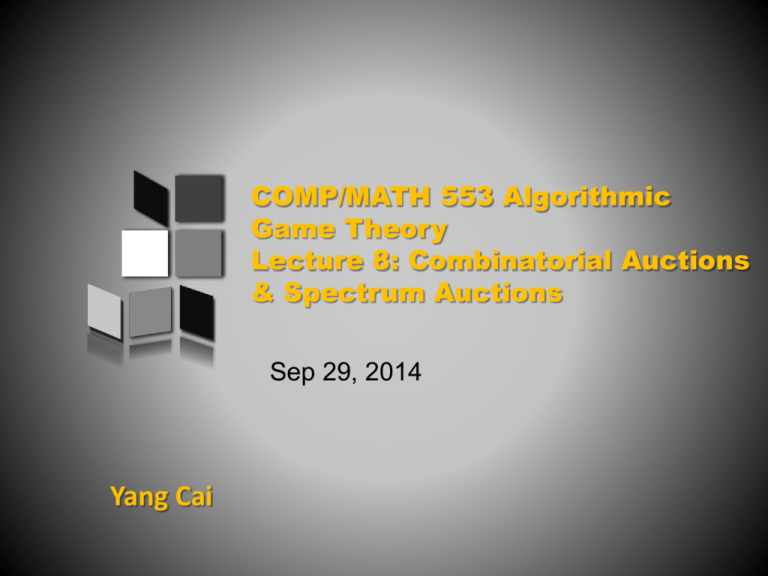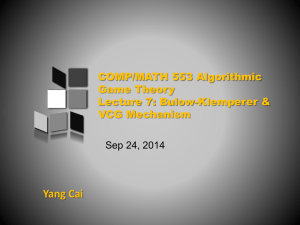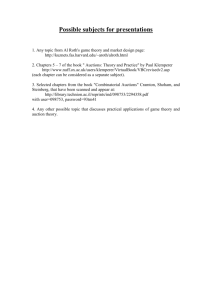Slides
advertisement

COMP/MATH 553 Algorithmic Game Theory Lecture 8: Combinatorial Auctions & Spectrum Auctions Sep 29, 2014 Yang Cai An overview of today’s class Vickrey-Clarke-Groves Mechanism Combinatorial Auctions Case Study: Spectrum Auctions The VCG Mechanism [The Vickrey-Clarke-Groves (VCG) Mechanism] In every general mechanism design environment, there is a DSIC mechanism that maximizes the social welfare. In particular the allocation rule is x(b) = argmaxω Σi bi(ω) (1); and the payment rule is pi(b) = maxω Σj≠i bj(ω) – Σj≠i bj(ω*) (2), where ω* = argmaxω Σi bi(ω) is the outcome chosen in (1). Discussion of the VCG mechanism DSIC mechanism that optimizes social welfare for any mechanism design problem ! However, sometimes impractical. How do you find the allocation that maximizes social welfare. If Ω is really large, what do you do? - m items, n bidders, each bidder wants only one item. - m items, n bidders, each bidder is single-minded (only like a particular set of items). - m items, n bidders, each bidder can take any set of items. Discussion of the VCG mechanism Sometimes Computational intractable. If you use approximation alg., the mechanism is no longer DSIC. Serves as a useful benchmark for more practical approaches! Combinatorial Auctions Combinatorial Auctions Important in practice - spetrum auctions - allocating take-off and landing slots at airports Notoriously hard in both theory and practice - In theory, many impossibility results for what can be done with reasonable communication and computation - In practice, badly designed combinatorial auctions with serious consequences Combinatorial Auctions (set-up) n bidders. For example, Bell, Rogers, Telus and several regional providers. There is a set M of m non-identical items. For example, a license for broadcasting at a certain frequency in a given region. An outcome is a n-dimensional vector (S1, S2, ..., Sn), with Si denoting the set of items allocated to bidder i (her bundle). All Si’s are disjoint! There are (n+1)m outcomes!!! Combinatorial Auctions (set-up) Each bidder could value every different outcome differently, but we simplify it a bit here. i has a private value vi(S) for each subset S of M. Each bidder needs 2m numbers to specify her valuation. - vi (Ø) = 0 - vi (S) ≤ vi (T), if S is a subset of T. (free disposal) - Could make other assumptions on the valuation function. Usually simplifies the auction design problem. Talk about it later. The welfare of an outcome (S1, S2, ..., Sn) is Σi vi(Si). Challenges of Combinatorial Auctions How do you optimize social welfare in combinatorial auctions? VCG! Unfortunately, several impediments to implementing VCG. Challenge 1 -- Preference elicitation: Is direct-revelation sealed-bid auction a good idea? No! Each bidder has 2m numbers to specify. When m=20, means 1 million numbers for every bidder. Indirect Mechanisms Ascending English Auction. The one you see in movies! Many variants, the Japanese variant is easy to argue about. The auction begins at some opening price, which is publicly displayed and increases at a steady rate. Each bidder either chooses “in” or “out,” and once a bidder drops out it cannot return. The winner is the last bidder in, and the sale price is the price at which the second-to-last bidder dropped out. Each bidder has a dominant strategy: stay till the price is higher than her value. Apply revelation principle on this auction, you get Vickrey auction. Indirect Mechanisms We’ll discuss the auction formats used in practice for the spectrum auctions. Main question: can indirect mechanism achieve non-trivial welfare guarantees? A lot of work has been done on this front. Short answer: depends on the bidders’ valuation functions. For simple valuations, “yes”; for complex valuations, “no”. Challenges of Combinatorial Auctions Challenge 2: Is welfare maximization tractable? Not always. E.g. Maximizing welfare for Single-minded bidders is NP-Hard. Doesn’t matter what auction format is used. This is hard to check in practice either. Challenges of Combinatorial Auctions Challenge 3: Even if we can run VCG, it can have bad revenue and incentive properties, despite being DSIC. Example: 2 bidders and 2 items, A and B. - Bidder 1 only wants both items: v1(AB) = 1 and is 0 otherwise. - Bidder 2 wants only item A: v2(AB) = v2(A) =1 and is 0 otherwise. - VCG gives both items to 1 and charges him 1. - Suppose now there is a third bidder who only wants item B: v3(AB) = v3(B) = 1 and is 0 otherwise. - VCG gives A to 1 and B to 2, but charges them 0! - Can you see a problem? Vulnerable to collusion and false-name bidding. Not a problem for Vickrey. Challenges of Combinatorial Auctions Challenge 4: indirect mechanisms are usually iterative, which offers new opportunities for strategic behavior. Example: bidders use the low-order digits of their bids to send messages to other bidders. - #378 license, spectrum use rights in Rochester, MN - US West and Macleod are battling for it. - US West retaliate by bidding on many other licenses in which Macleod were the standing high bidder. - Macleod won back all these licenses but had to pay a higher price - US West set all bids to be multiples of 1000 plus 378! Spectrum Auctions Selling Items Separately Indirect mechanisms. Have relax both DSIC and welfare maximization. Obvious mechanism to try is to sell the items separately, for each, use some singleitem auction. Main take away is: for substitutes this works quite well (if the auction is designed carefully), but not for complements. - substitutes: v(AB) ≤ v(A) + v(B) - complements: v(AB) > v(A) + v(B) Welfare maximization is computationally tractable when the items are substitutes and true valuations are known. But it’s still intractable for complements. In real life the items are a mixture of substitutes and complements. When the problem is “mostly substitutes”, then selling items separately could have good performance. Selling Items Separately Rookie mistake 1: Run the single-item auctions sequentially, one at a time. Imagine the items are identical and you have k copies. DSIC mechanism gives the top k bidders each a copy of the item and charge them the (k+1)-th highest bidder’s bid. What if you run it sequentially? Say k=2. If you are the highest bidder will you bid truthfully for the first item? Everyone will do the same reasoning, in the end the outcome is unpredictable. Selling Items Separately In March 2000, Switzerland auctioned off 3 blocks of spectrum via a sequence of Vickrey auctions. The first two were identical items , 28 Mhz blocks, and sold for 121 million and 134 million Swiss francs. For the third auction, the item is a larger 56 MHz block. The price was only 55 million. This is clearly far from equilibrium. Not close to optimal welfare and low revenue as well. Lesson learned: holding the single-item auction simultaneously, rather than sequentially. Selling Items Separately Rookie mistake 2: Use sealed-bid single-item auctions. Imagine the items are identical and each bidder wants only one of them. Two reasonable things to do: (1) pick one item and go for it (2) bid less aggressively on multiple items and hope toget one with a bargain price and not winning to many extra ones. But which one to use? Tradeoff between winning too few and twinning too many. The difficulty of bidding and coordinating gives low welfare and revenue sometimes. Assume 3 bidders competing for two identical item, and each wants only one. Selling Items Separately In 1990, New Zealand government auctioned off essentially identical licenses for television broadcasting using simultaneous (sealed-bid) Vickrey auctions. The revenue in the 1990 New Zealand auction was only $36 million, a paltry fraction of the projected $250 million. On one license, the high bid was $100,000 while the second-highest bid (and selling price) was $6! On another, the high bid was $7 million and the second-highest was $5,000. The high bids were made public ... Every one can see how much money was left on the table ... They later switched to first-price auction, same problem remains, but at least less evident to the public ... Simultaneous Ascending Auctions (SAAs) Over the last 20 years, simultaneous ascending auctions (SAAs) form the basis of most spectrum auctions. Conceptually, it’s a bunch of single-item English auctions running in parallel in the same room. Each round, each bidder place a new bid on any subset of items that she wants, subject to an activity rule. Basically the rule says: the number of items you bid on should decrease over time as prices rise. Simultaneous Ascending Auctions (SAAs) Big advantage: price discovery. This allows bidders to do mid-course correction. Think about the three bidders two item case. Another advantage: value discovery. Finding out valuations might be expensive. Only need to determine the value on a need-to-know basis.



